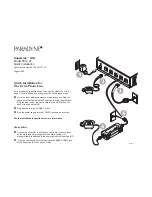
LAVA Computer MFG Inc.
nSynC-Staging Reference Manual - Rev A05
2 Vulcan St. Toronto, ON
Tel: +1 416 674-5942
www.lavalink.com
Canada, M9W 1L2
Toll Free (US & Canada): 800 241-5282
8 of 10
Connection Descriptions
USB-
C “Mobile Device” Data & Power Outputs
The “Mobile Device” receptacles are standard USB-C receptacles, which are used for the
connection between the nSynC-Staging adapter and up to four tablets or smartphones. This
connection provides a power and data connection to the devices.
The cable should not exceed the 1.5 meter (5 foot) limit defined by the specifications. The cable
need not be electronically marked due to the current levels involved.
The USB-C cables must support
both data and charging.
It does not matter which end of the cable is attached to the device or the nSynC-Staging.
USB-
C “Power Adapter” Input
The “Power Adapter” input is a USB-C receptacle on the nSynC-Staging adapter. This input
provides power for the adapter and the devices.
The nSynC-Staging does not function if power has not been applied to the Power Adapter input.
The nSynC products are not intended to draw power from the mobile device.
The nSynC-Staging adapter requires a USB-C power supply. For SimulCharge to work, it needs
to be at least 45-watt capable. The nSynC-Staging adapter can charge the devices at 9 volts, 1
amp each, if they are capable of Fast Charging. If the mobile devices do not support Fast
Charging, they will be charged at 5 volts, 1.8 amps.
The cable length between the power supply and the nSynC product must be as short as possible.
The cable experiences power loss proportional to the cable length and wire thickness. The
voltage present at the nSynC receptacle will be lower than the supply output due to cable power
loss. There is power loss in the cable which connects the nSynC to the device. If the voltage at
the device is too low, the device will not charge.
Note: Any standard USB-C charger (5V 2A minimum) will work if you are using the adapter in
OTG mode.
Mode Select Button
The nSynC-Staging adapter uses a blue momentary push-button and pair of LEDs for
configuration management. The push-button is labeled "Mode Select", and is referred to as the
"Mode button" in this document.
The Mode button is used to switch between SimulCharge and OTG modes. You must hold down
the button for five seconds to switch modes. The yellow and green LEDs next to the button will
blink when the button is pressed. When you let go, the LEDs will remain on if you chose OTG
mode and they will turn off, if you chose SimulCharge mode




























